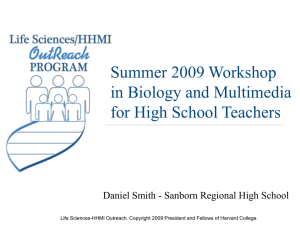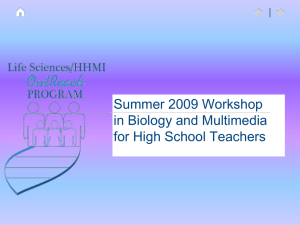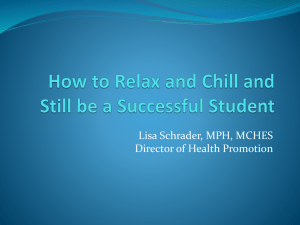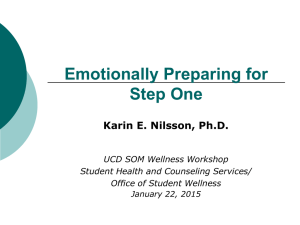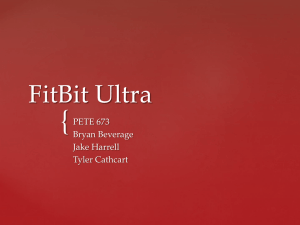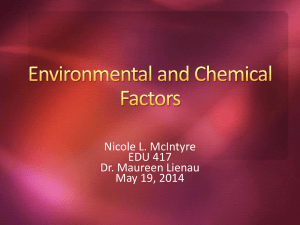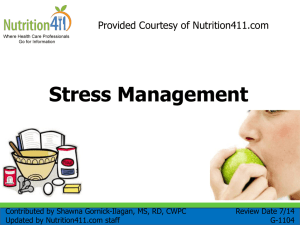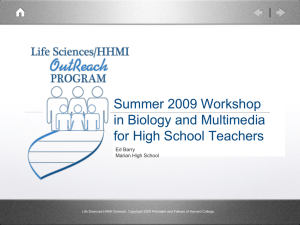The Science of Sleep - Life Sciences Outreach at Harvard University
advertisement
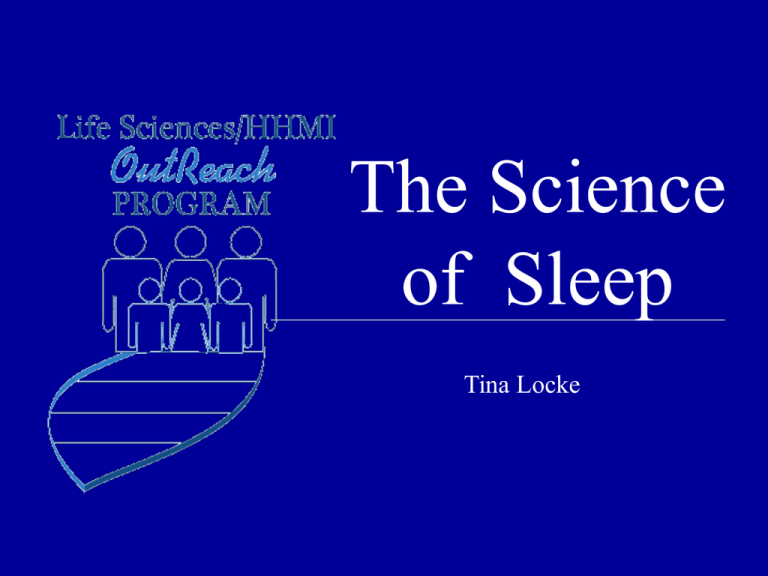
The Science of Sleep Tina Locke Sleep Patterns Weekdays: Weekend days: • What time do you go to bed? • What time do you go to bed? • What time do you wake up? • What time do you wake up? Do you think you get enough sleep? Life Sciences-HHMI Outreach. Copyright 2009 President and Fellows of Harvard College. Question # 8 Sleep is a time for the body and brain to shut down for rest. Disagree Sleep is a dynamic process: Some increased brain activity Endocrine systems increases secretions of certain hormones What is sleep video Life Sciences-HHMI Outreach. Copyright 2009 President and Fellows of Harvard College. Question # 6 Most teens need at least nine hours of sleep each night. Agree Teens do need at least 9 hours of sleep per night Teens need more sleep than adults Most teens do not get enough sleep Life Sciences-HHMI Outreach. Copyright 2009 President and Fellows of Harvard College. Why is sleep important? • • • • • Memory Concentration Motor response/reaction Controlling emotions School/work/athletic performance Life Sciences-HHMI Outreach. Copyright 2009 President and Fellows of Harvard College. Sleep Regulation Sleep variables: Regulated by: • Duration • Circadian system (Biological clock) • Sleep intensity • Homeostatic mechanism (Tobler and Achermann) Life Sciences-HHMI Outreach. Copyright 2009 President and Fellows of Harvard College. Sleep Cycles 1. Biological clock – when 2. NREM/REM – how 3. Sleep Homeostasis - need Life Sciences-HHMI Outreach. Copyright 2009 President and Fellows of Harvard College. Question #1 Everyone has a biological clock. True The timing of sleep in humans is regulated by our biological clock Life Sciences-HHMI Outreach. Copyright 2009 President and Fellows of Harvard College. (1) Biological Clock • Cycle: a little longer than 24 hour period “CIRCADIAN CLOCK” • circa=about • diem=day • Clock Regulates: – Seasonal reproductive cycles – Sleep/wake cycles • External and internal rhythms. Life Sciences-HHMI Outreach. Copyright 2009 President and Fellows of Harvard College. (1) Biological Clock Question # 9 The body quickly adjusts to different sleep schedules? False Circadian clock works on day/night schedule, despite attempts to change it Clock can sometimes be reset, but only by an hour or two. Life Sciences-HHMI Outreach. Copyright 2009 President and Fellows of Harvard College. (1) Biological Clock Circadian Rhythms Two Clock Rhythms External (environmental) rhythm Internal rhythm Life Sciences-HHMI Outreach. Copyright 2009 President and Fellows of Harvard College. (1) Biological Clock External rhythm LIGHT Clock location: suprachiasmatic nucleus (SCN) of the hypothalamus in the brain At SCN signals interact with genes (active/inactive) to serve as “pacemakers” http://en.wikipedia.org/wiki/File:Circadian_rhythm_labeled.jpg Life Sciences-HHMI Outreach. Copyright 2009 President and Fellows of Harvard College. (1) Biological Clock Internal rhythm Rhythm continues in absence of environmental cues Cycles just over 24 hours, bedtime 1 hour later each night. 24 days back to same bedtime. Biological Clock Video Life Sciences-HHMI Outreach. Copyright 2009 President and Fellows of Harvard College. (2) NREM/REM (Ultradian Rhythm) Slow wave - Non Rapid Eye Movement (NREM) Rapid Eye Movement (REM) Life Sciences-HHMI Outreach. Copyright 2009 President and Fellows of Harvard College. (2) NREM/REM NREM • Slow wave – Low muscle movement – Limited eye movement Brain distributes information into networks & categories. (FRONTLINE) Connections between nerve cells strengthen - consolidating new skills. (FRONTLINE) Life Sciences-HHMI Outreach. Copyright 2009 President and Fellows of Harvard College. (2) NREM/REM REM • REM – Burst of rapid eye movement – Almost paralyzed Brain re-enacts previous day(FRONTLINE) Solidifies newly made connections through memory banks (FRONTLINE) Life Sciences-HHMI Outreach. Copyright 2009 President and Fellows of Harvard College. (2) NREM/REM Practice makes perfect!! Nova Sleep V ideo Life Sciences-HHMI Outreach. Copyright 2009 President and Fellows of Harvard College. (3) Sleep Homeostasis (Homeostatic “rhythm”) Homeostasis: maintaining internal equilibrium by adjusting internal processes Sleep pressure increases when awake Sleep pressure decreases during sleep Life Sciences-HHMI Outreach. Copyright 2009 President and Fellows of Harvard College. (3) Homeostasis Sleep Homeostasis Molecule Adenosine: •Keep tracks of sleep loss •May induce sleep Caffeine binds and blocks receptors Hormone melatonin: •Levels rise during the night •Levels decline at dawn Controlled by the clock Sleep Homeostasis Video Life Sciences-HHMI Outreach. Copyright 2009 President and Fellows of Harvard College. Sleep Cycles Circadian patterns typical of someone who rises early in morning, eats lunch around noon, and sleeps at night (10 p.m.) http://commons.wikimedia.org/wiki/File:Biological_clock_human.PNG. 1) Biological Clock - when 2) NREM/REM - how 3) Homeostasis - need Life Sciences-HHMI Outreach. Copyright 2009 President and Fellows of Harvard College. Why is sleep important? • • • • • Memory Concentration Motor response/reaction Controlling emotions School/work/athletic performance Life Sciences-HHMI Outreach. Copyright 2009 President and Fellows of Harvard College. Question #10 Getting one hour less sleep per night than I need will not have any effect on my daytime performance. False small, regular, decreases can effect daytime performance. Life Sciences-HHMI Outreach. Copyright 2009 President and Fellows of Harvard College. What are good and bad sleep habits? Good Sleep Habits Bad Sleep Habits Life Sciences-HHMI Outreach. Copyright 2009 President and Fellows of Harvard College. What are some consequences of bad sleep habits? Individually Socially Life Sciences-HHMI Outreach. Copyright 2009 President and Fellows of Harvard College. Question #3 Safe drivers don’t have to worry about being sleepy? False Sleepiness = decrease in alertness Decrease in alertness ≠ safe driving Life Sciences-HHMI Outreach. Copyright 2009 President and Fellows of Harvard College. Question # 7 Driving makes you sleepy. False Driving makes your level of sleepiness apparent Safest to drive during alert times Life Sciences-HHMI Outreach. Copyright 2009 President and Fellows of Harvard College. References Unless otherwise noted within the presentation, information, charts and graphs have been obtained from NIH Curriculum Supplements for Grades 9-12. Sleep Disorders and Biological Rhythms. 1. 2. 3. 4. 5. 6. 7. NIH Curriculum Supplement Series for Grades 9-12. Sleep Disorders and Biological Rhythms. National Institutes of Health http://science.education.nih.gov/customers.nsf/HSSleep?OpenForm FRONTLINE. Adolescents and Sleep, A Summary of What Researchers Know About Teenagers’ Need for Sleep and Why Sleep Affects Memory and Learning. http://www.pbs.org/wgbh/pages/frontline/shows/teenbrain/from/sleep.html#fnB0 Jenni OG., Achermann P. and Carskadon MA. Homeostatic sleep regulation in adolescents. SLEEP 28 (2005) 1446-1454. Tobler, Irene and Achermann, Peter, Sleep homeostasis.http://www.scholarpedia.org/article/Sleep_homeostasis What is Sleep, Biological Clock and Homeostasis videos: http://www.videojug.com/interview/healthy-sleep-for-children#what-is-our-bodys-internal-clock Biological clock diagram http://commons.wikimedia.org/wiki/File:Biological_clock_human.PNG. Nova sleep movie: http://www.teachersdomain.org/resource/oer08.sci.life.reg.sleep/ Life Sciences-HHMI Outreach. Copyright 2009 President and Fellows of Harvard College.

